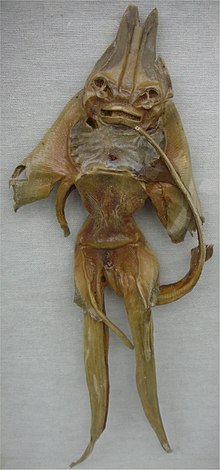Jenny Haniver

A Jenny Haniver is the carcass of a ray or a skate that has been modified by hand then dried, resulting in a mummified specimen intended to resemble a fanciful fictional creature, such as a demon or dragon.[1][2][3] This practice dates back to the 16th century when these specimens were often sold as curiosities to sailors and collectors.
Name
[edit]One suggestion for the origin of the term was the French phrase jeune d'Anvers ("youth of Antwerp"). British sailors "cockneyed" this description into the personal name "Jenny Haniver".[1][3]
History
[edit]Jenny Hanivers have been created to look like various mythical creatures, including devils, angels and dragons. Some writers have suggested the sea monk may have been a Jenny Haniver.[1]
The earliest known picture of Jenny Haniver appeared in Konrad Gesner's Historia Animalium vol. IV in 1558. Gesner warned that these were merely disfigured rays and should not be believed to be miniature dragons or monsters, which was a popular misconception at the time.[3][4][5]
The most common misconception was that Jenny Hanivers were basilisks. As basilisks were creatures that killed with merely a glance, no one could claim to know what one looks like. For this reason it was easy to pass off Jenny Hanivers as these creatures, which were still widely feared in the 16th century.[6]
In Veracruz, Jenny Hanivers are considered to have magical powers and are employed by curanderos in their rituals.[7] This tradition is similar to one in Japan, where fake taxidermy ningyo (similar to Fiji mermaids) were produced and kept in temples.
Gallery
[edit]In popular culture
[edit]- The Jenny Haniver and Jenny Haniver II are airships in the Mortal Engines Quartet (2001–2006) series of novels by Philip Reeve, and a boat in one of its prequels, A Web of Air (2010).
- The Bermuda Depths, a 1978 fantasy film starring Leigh McCloskey and Connie Sellecca, featured the latter as a mysterious character named "Jennie Haniver".
- In the 2022 video game Splatoon 3, a Jenny Haniver is available as a purchasable locker decoration under the name “mysterious dried thing”.
See also
[edit]References
[edit]- ^ a b c "Journal of the Bizarre". 23 May 2012. Retrieved 15 November 2014.
- ^ Roger G-S (15 October 2012). "Roles, Rules, and Rolls: Monster Monday: Jenny Haniver, Sea Clergy, and Morkoths". Retrieved 15 November 2014.
- ^ a b c "jenny hanivers - Poems Underwater". Retrieved 15 November 2014.
- ^ "Jenny Haniver". Wondercabinet. Retrieved 15 November 2014.
- ^ Sophia Hendrikx (November 1, 2018). "Fantastic Beasts and How to Make Them (according to 16th century instructions)". Retrieved July 13, 2022.
While Gessner was not the first to describe a Jenny Haniver, he was the first to explicitly describe it as a man-made object, and to explain how it was made. His instructions read as follows:
"In order to impress common people, apothecaries and others dry rays and twist their skeletons into all sorts of remarkable poses, making the animal look like a snake or a winged dragon. They twist the body, alter the shape of the head and mouth, and remove other parts or make them smaller. The lower part of the body is cut, and what remains is lifted, to make it look like the creature has wings." - ^ Peter Dance. Animal Fakes and Frauds.
- ^ "FOTOS El diablo, un pez para la magia negra - El Universal Veracruz" (in Spanish). Archived from the original on 28 May 2014. Retrieved 15 November 2014.
Text is available under the CC BY-SA 4.0 license; additional terms may apply.
Images, videos and audio are available under their respective licenses.



